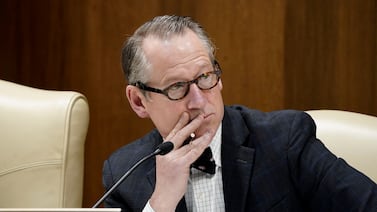Jeffco school board members are pushing district leaders to move more quickly on changes meant to boost the number of students who read well by the end of third grade.
Board members expressed frustration last week over the district’s plan to switch to state-approved reading curriculum during the 2021-22 school year, saying poor reading achievement has plagued the district for years. They cited the patchwork quilt of reading programs used in district schools, the lack of a consistent centralized approach, and a surge in COVID-related learning loss.
Board member Brad Rupert said at the Nov. 5 board meeting, ”Our literacy challenges predate COVID and so, to be honest, … I’m growing impatient with where we are and the lack of real problem-solving.”
Board member Susan Miller worried that with up to a year and a half until all schools have state-approved curriculum, literacy instruction won’t change much until 2023.
“I think we need to put the fire under ourselves and say we need to be more accountable,” she said, citing new data showing the growing number of struggling readers in the district.
“They will never catch up,” she said.
The discussion in Colorado’s second-largest school district reflects an issue cropping up in many school districts right now amid state efforts to beef up teacher training on reading and push schools to use better reading curriculum. The Denver, Cherry Creek, Aurora and Douglas County districts all use reading programs in some schools that will have to be replaced because the state has judged them unacceptable. If districts don’t make a good-faith effort to switch, they could face state sanctions.
Matt Flores, Jeffco’s chief academic officer, told board members that district staff have been reviewing state-approved reading programs since June, and will spend the coming months collecting feedback from teachers and others, analyzing the cost of new reading programs, and seeking proposals from vendors.
“Our declining reading scores are an urgent need to all of us and we are working incredibly hard to learn from the experience of professional educators, to learn from experts across the country and experts within our system,” he said.
The 109 elementary and K-8 schools in the 84,000-student Jeffco district use more than two dozen different core reading programs, according to a list released by district officials in October. Only one-third of schools use programs that have been approved by the state. The rest either use a discredited reading program commonly called “Lucy Calkins,” a mish-mash of curriculums, or a set of district-created resources that teachers have criticized for being hard to navigate and incomplete.
Candice Steinke, a second grade teacher at the district’s Foothills Elementary School, said there’s been a different reading program or combination of programs at each of the four schools where she’s worked during her 11 years in Jeffco. Many of the materials cover some key components of reading, but skip over other fundamentals.
“We need reading curriculum that is systemic, not a pick-and-choose,” she said. “We just constantly watch these kids fail.”
Steinke said the district-created set of reading materials, often referred to as “Bridge to Curriculum,” is “very broad … doesn’t offer any differentiation and it doesn’t tell me how to teach reading specifically.”
Teachers don’t get much training on commercial reading programs used in the district either, she said. Her main choices are usually the teacher’s manual or webinars.
Steinke said she’d like to see the district select one or even a small number of comprehensive state-approved reading programs.
“If the district doesn’t pick something, they’re hurting kids that move around a lot, especially kids experiencing poverty.”
In Jeffco, only 46% of third-graders met expectations on the state’s 2019 English language arts test, which measures reading and writing. It’s a problem exacerbated by coronavirus-related school disruptions. At last week’s board meeting, district officials shared fall test results showing that more K-3 students — especially first-graders — are far behind in reading this year compared with the previous year.
Andrew Gitner, an English teacher at Golden High School, believes the wide range of reading levels he sees in his students, with some many years behind, indicates problems with early reading instruction.
He said the district takes a piecemeal approach to teaching reading, with different schools emphasizing different reading skills and methods.
Compared with New York where he grew up and did his student teaching, Gitner said, “This is very much the wild west. It’s very much about local control. But when it comes to something that can be so evidence-based as reading instruction, maybe that’s not the best.”
One of the biggest outstanding questions for Jeffco leaders is how they’ll pay for new reading curriculum, which could have an initial price tag of several million dollars, with additional costs in subsequent years.
While Board President Susan Harmon agreed that improving literacy is a priority for the board, she emphasized the board’s responsibility to act on that during budget season.
“I will say to the board, remember this when we come to budget discussions because we have this conversation a lot and then things get cut,” she said.
Clarification: An earlier version of this story failed to mention that state literacy tests measure both reading and writing, not just reading.
This story was produced with support from the Education Writers Association Reporting Fellowship program.







